Altering a soap recipe is nothing like altering a food recipe. Learn how to make adjustments to a soap recipe without ruining it with the help of a lye calculator.
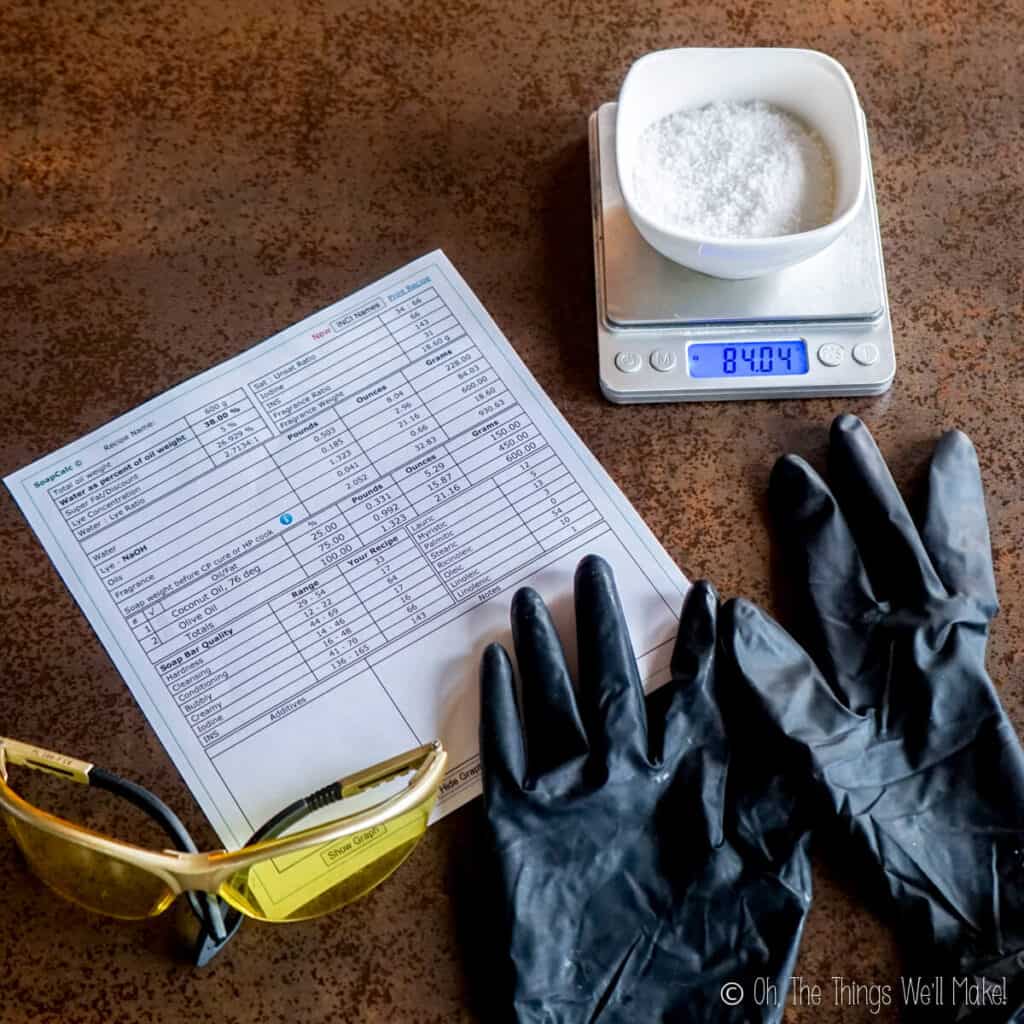
Over the years, I have gotten a lot of questions from people wanting to modify one of my soap recipes.
They are either wanting to switch out one of the oils, or they already did switch them and can’t figure out why the soap isn’t as hoped!
Why do you need a lye calculator?
Unlike with food recipes, you can’t just easily switch out the oils used and expect the recipe to turn out mostly the same.
In a cake recipe, for example, it’s pretty simple to swap out butter for ghee or for vegetable oil. You can generally use any mild-flavored fat or oil: Expeller pressed coconut oil is a good example.
There are several reasons that you can’t just sub out oils in a soap recipe…
Saponification values
Different oils have different saponification values.
Did I already lose you?
I know that sounds intimidating, but it basically means that each type of oil will need a different amount of lye to make soap. That’s the exact amount of lye that you’ll need to react with all of that particular oil and not have any of either oil or lye leftover.
Superfatting
If you use more oil than the exact amount of lye needed, you’ll have “superfatted” the soap. (I can explain that more in-depth some other day, but it basically means that you’ll have leftover, unreacted oils in your soap.)
Superfatting a soap can be a good idea when making soaps meant for face or body. The unreacted oils will help condition your skin and keep it from drying out too much when using the soap.
Lye Excess
If you use too much lye, you’ll end up with a “lye heavy” soap. Soap already has a naturally high pH (generally over 9). If you make a lye heavy soap, it will be even higher. That can make it be irritating to the skin.
If you’re making a soap for general cleaning, and plan to use it with gloves, it probably isn’t going to be that much of a problem, but if you want a mild soap, you definitely don’t want to use too much lye.
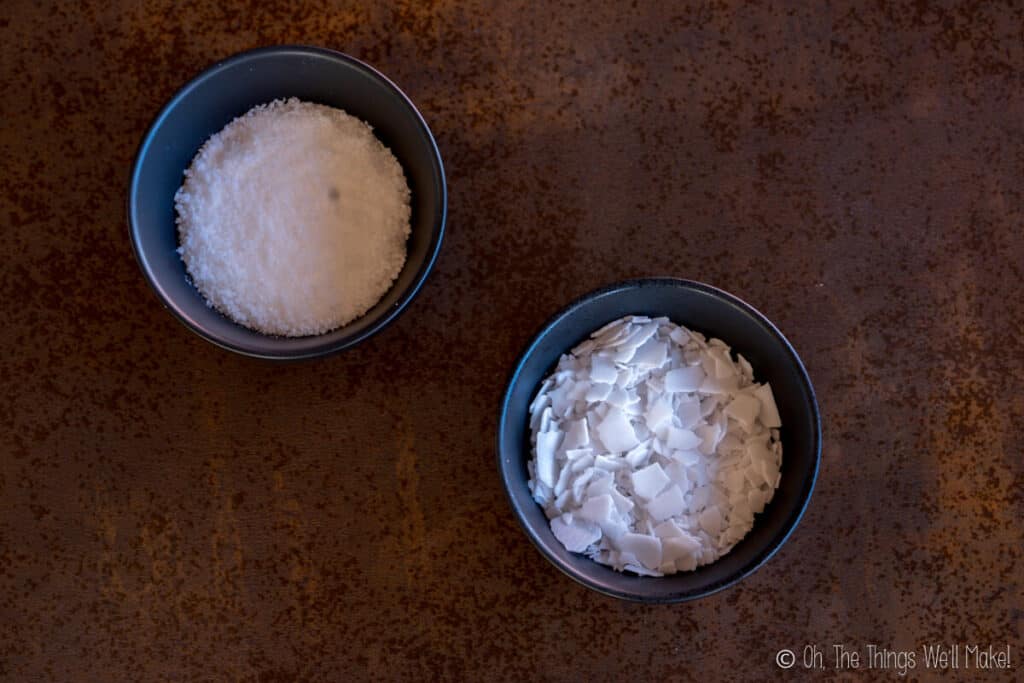
Different oils behave differently in soap
The different saponification values aren’t the only reason that you can’t just randomly switch out oils, though.
Oils behave much differently when they’ve been made into soap (vs. how they behave in a lotion). I’ve written more in depth on this subject in my post about the best oils for soap making, but I can summarize the general idea here.
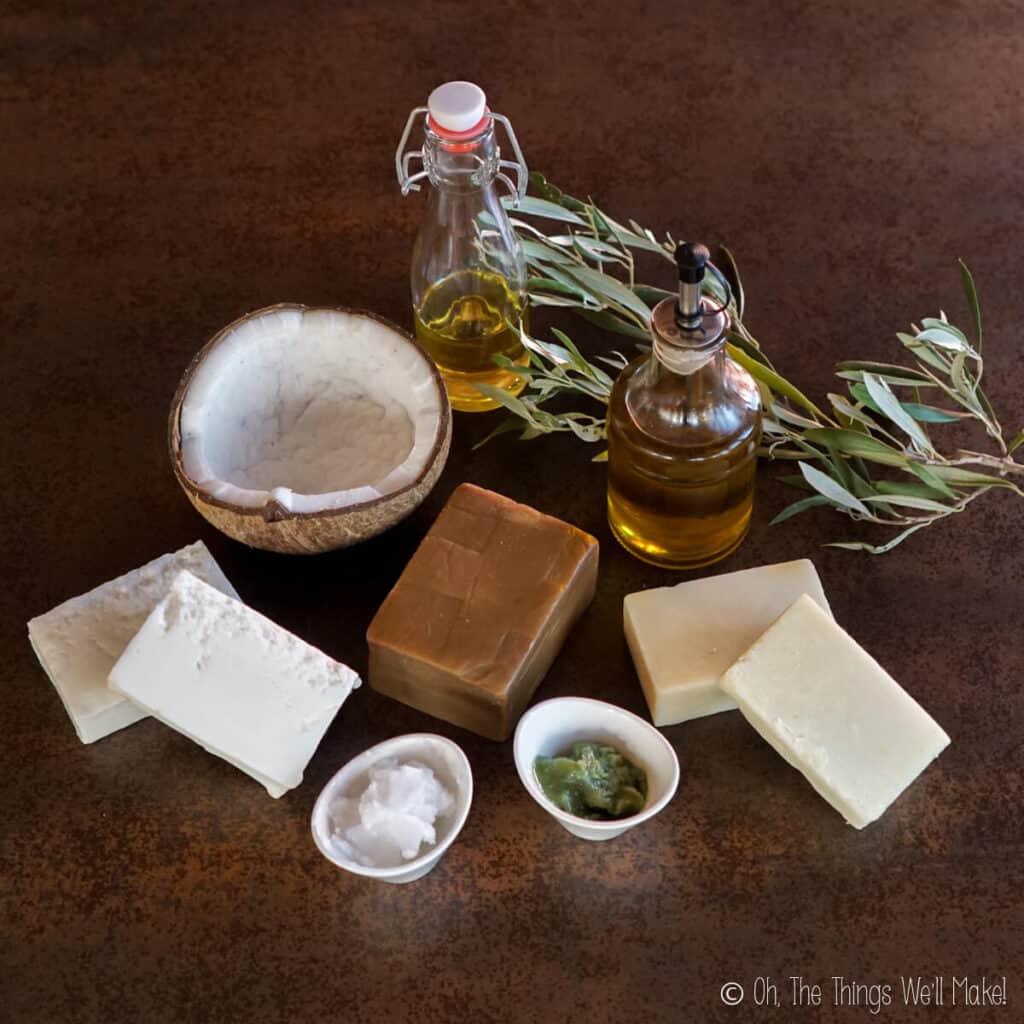
Solid oils vs. liquid oils in soap
Solid oils like coconut oil, palm oil, and animal fats, tend to make very stable soaps. They usually are pretty good at cleaning, and they also give a lot of lather. I love coconut oil-based soaps, and I used coconut oil as the only oil in my beginner laundry soap recipe.
Liquid oils, like vegetable oils, tend to make a softer soap that isn’t as cleansing and doesn’t lather as much. Most vegetable oils don’t make very good bars of soap on their own. They also tend to make soaps that are too soft and that go rancid or develop “Dreaded orange spots” (DOS). They usually need to be combined with other oils to get a decent, long-lasting soap that will cleanse well, get hard, and will lather well.
Olive oil in soap
Olive oil is a bit of an exception when it comes to the liquid oils as it can make a hard bar of soap eventually. It can also make a long-lasting bar of soap, even when used on its own in a recipe. In fact, it is often cured for very long periods of time in order to improve the soap.
I have shared a recipe for a pure Castile soap, a soap made only with olive oil, but many people find pure Castile soaps to be “slimy”. That’s because they are very “conditioning” and don’t provide a lot of lather or deep cleansing. On the other hand, other people love Castile soap for that very reason; their sensitive skin appreciates a milder, less cleansing soap.
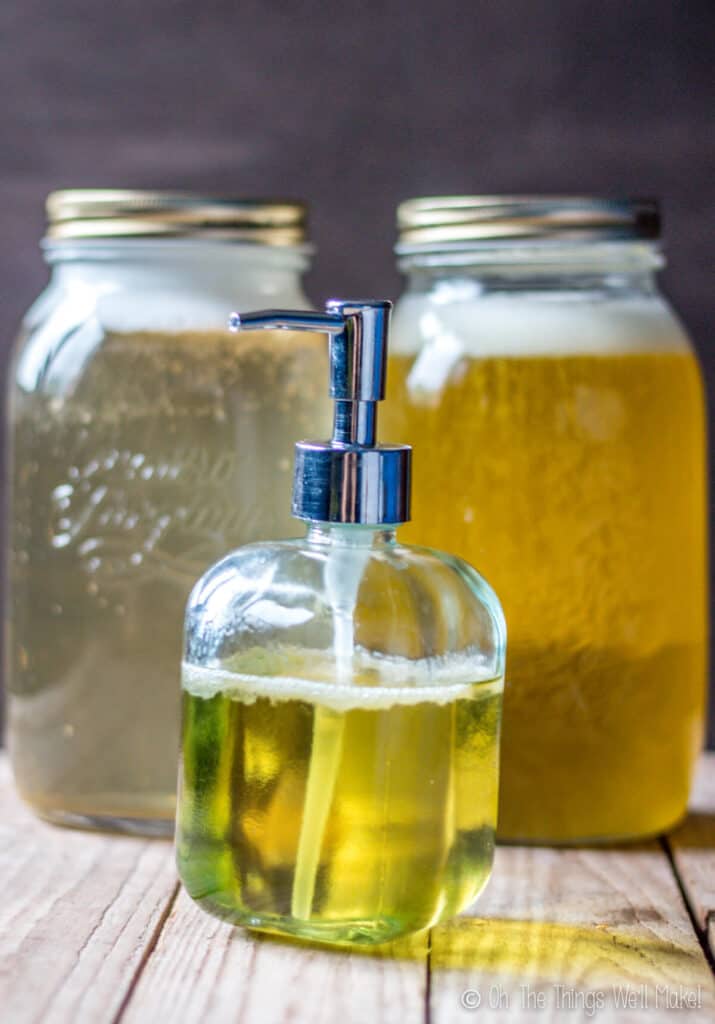
Oils in liquid soaps
Interestingly enough, I haven’t found liquid soaps to show such extreme differences in their properties; at least not when considering olive oil vs. coconut oil.
Despite the fact that bar soaps made with coconut oil vs. olive oil are completely different in appearance and behave completely distinctly, liquid soaps made with coconut oil vs. olive oil are actually quite similar (with the exception of the coconut oil liquid soap being lighter in color).
I had originally posted both a pure olive oil liquid Castile soap recipe and a pure coconut oil liquid soap recipe with the intention of mixing them in differing quantities depending on how I was going to use them. (I wanted to use more of the pure Castile made with olive oil for bathing and more of the coconut oil one for general cleaning.) Nowadays, I normally only make the coconut oil liquid soap as I like its light color and it’s the most inexpensive to make.
Switching out the oils in a soap
I occasionally get comments from readers about how they have modified a soap recipe.
I made the recipe exactly as written, except I switched out the coconut oil for canola oil because I had a lot I wanted to use up. Mine didn’t set up well. What’s wrong with the recipe?
Or maybe their complaint is that the soap was too soft, or it started developing orange spots, etc.
Whatever the issue, I have to begin by pointing out that they didn’t really make the recipe as written.
Not only is it very possible that the lye amount would need to be modified to accommodate for the new oil, but we also have to consider that even if the new formula was made with the right amount of lye, you would probably end up with a soap with completely different properties!
In my hypothetic situation above, canola oil is nothing like coconut oil when used in soap making. The resulting soap would be nothing like the original formulation!
Substitute with similar oils.
If you still would like to make a switch to a recipe, there are a few things that you need to do to make sure that you are going to end up with a decent soap.
First, choose an oil that is similar to the one that you are trying to replace.
In most cases, you can switch out an animal fat for another animal fat, or a liquid vegetable oil for another similar liquid vegetable oil.
If a recipe only uses a small amount of the oil that you don’t want to use, you can usually get away with a more drastic change, but it’s still not a great idea to switch out a solid oil for a liquid oil if you can avoid it.
When I say to make the above substitutions, though, don’t think you can just swap out the same amount of oil and be finished with it.
First, you will need to run the new formulation through a lye calculator!
What is a lye calculator?
Looking at the table of saponification values of soap can be intimidating. There are a lot of numbers, and to formulate your soap using that table, you’d have to do a lot of math to try to figure out how much lye to use in your soap.
A lye calculator is a tool that helps simplify things by calculating the amount of lye you need according to the oils you choose for your recipe.
To use a lye calculator, you input the oils you want to use, the amount of each oil you plan on using, and you can also specify if you want to superfat the soap or not. (Remember, that means you’ll leave leftover oils that help condition the skin and keep the soap from being too drying.)
Some lye calculators, like Soapcalc, will even help you predict what your resulting soap will be like. It shows you values for different soap properties like how “cleansing” it will be, how “conditioning” it will be, or how much lather it will likely make.
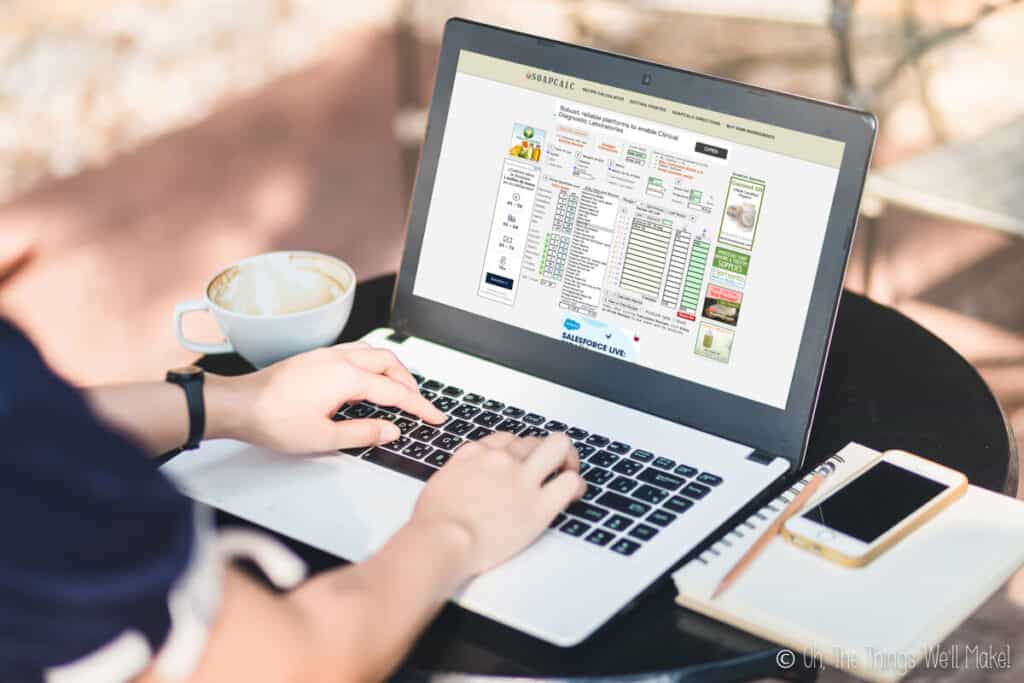
Which lye calculator is best?
There are many lye calculators online that work in slightly different ways. Choosing one will really depend on the type of recipe you are formulating, your preferences in style and appearance, and what information you are looking for. It may also depend on the oils/fats/waxes you are using in your soap as some calculators won’t have certain fats listed as one of their options.
I tend to stick to 2 different lye calculators, but occasionally will use others, as needed.
The best lye calculator for formulating bar soaps
Whether or not it’s actually the best lye calculator for formulating bar soap recipes is debatable, I guess. But I’ve gotten used to using the Soapcalc lye calculator whenever I formulate new bar soap recipes.
The reason I like Soapcalc for formulating new recipes is that it gives you a lot of information that helps you predict what your new soap is going to be like.
How to use the Soapcalc lye calculator
Let’s take a look at the soapcalc calculator and try to formulate a very basic soap. We can go in order, looking at the differently numbered sections in the calculator.
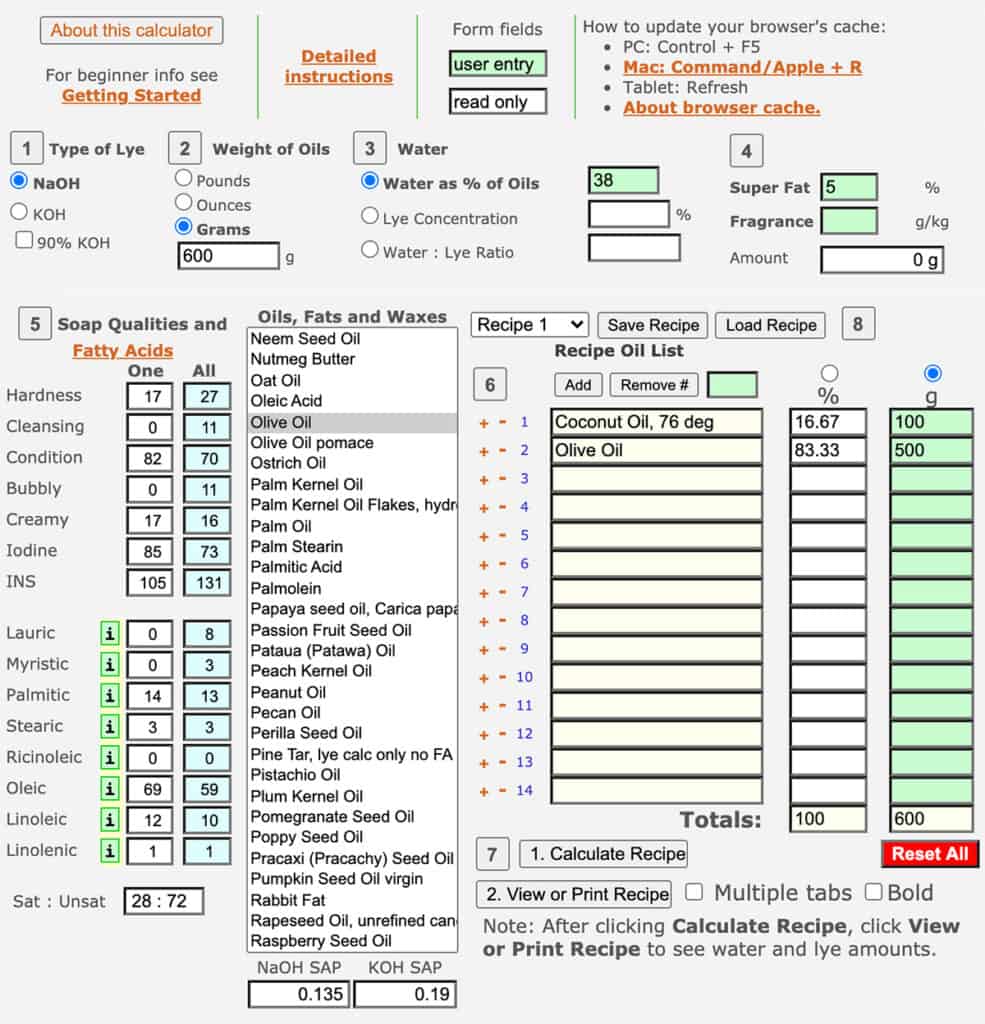
Type of lye
The first section lets you input what type of lye you are planning on using in your soap. You’ll see that you are given two main options, NaOH and KOH.
NaOH refers to sodium hydroxide. It’s the more commonly found lye, and the one that is normally used to make bar soaps.
KOH refers to potassium hydroxide. It’s usually used in liquid soap recipes.
While most soaps use one or the other, you also have the option of combining the different types of lye. This allows you to make soaps with a different texture like cream soaps or soft shave soaps.
Weight of oils
The next section of the lye calculator asks about the weight of the oils. This part is asking you if you want to work in pounds or ounces and, indirectly, how much soap you want to make.
I usually work in grams because I find it less confusing. (Make sure to use weight ounces and not liquid ounces if you choose ounces!)
For the loaf pan I normally use, I normally make my batches of soap with around 600g of oils. You can choose to make more or less, though, depending on the molds you choose and how big of a batch you want to make.
Water section
The next section of the lye calculator lets you adjust the non-oil liquids of your recipe.
First, they ask you about Water as % of oils. They give you a default amount of 38% which will work well for most recipes. Some people find this to be too much water, though. If you want a harder bar of soap, you might consider trying to lower the amount of liquid in the recipe. This is usually called “water discounting.”
By lowering the amount of water used in a soap, you may also reduce the curing time, the time it takes to be able to unmold, etc. Soapcalc suggests sticking somewhere between 33-38%.
If you don’t want to work with “water as % of oils,” you can change to one of the other options: lye concentration or water to lye ratio. If you’re just a beginner, though, I’d probably just stick with the default value for that section.
Superfat and fragrance
This section allows you to state how much of an excess of fats you want in your soap. Having unreacted oils helps your soap feel more conditioning. Too much, though, can make a soap soft. How much you can superfat depends on the oils you choose for your soap.
Generally speaking, when using oils like coconut that are said to be drying but that also make a hard bar of soap, you can superfat at a higher percentage, even over 10%.
If using more liquid oils in your soap, though, superfatting over 10% is probably going to result in a soft bar of soap that isn’t as cleansing.
The default in the Soapcalc lye calculator is 5%. I think 5-8% is a good range to play with, depending on what type of soap you are making.
When I make laundry soap, I don’t superfat at all because my main goal for that soap is to clean well! I don’t superfat my liquid soaps either because excess oils can make them cloudy.
I generally don’t calculate out fragrances, as I tend to prefer unscented soaps or those with only a few essential oils that I add, by eye, later on. That said, the fragrance section will help you calculate a proper amount to use. Their default number is 0.5 ounces per pound.
Recipe oils list
For now, you can skip the soap qualities and fatty acids section. We’ll take a look at that section after calculating our recipe.
Now, we can start playing with the values in the recipe oils list. To do so, choose the oils that you are planning to use in your soap.
Click on one of the oils, fats, or waxes and then, when it gets highlighted, click on the plus sign to its right. That adds the oil to your recipe oil list.
Once you have added all of the oils that you want to use to the list, decide how much of each oil you want to use. This can be written in by percentage or by the weight of each oil by filling in the blanks in one of the columns, either underneath the % or oz. or g. (Whether it shows oz. or g will depend on which you’ve chosen earlier in the top part of the calculator).
Calculating the recipe
Once you’ve added all of the oils and their amounts, hit the “calculate recipe” button. Once you’ve done that, you’ll notice that the calculator will fill in all of the values in the soap qualities and fatty acids section.
Seeing the numbers there may seem meaningless to you, but the soap calculator will also show you a good range to shoot for.
To see the range guidelines, click on the “view or print recipe” button. A new tab should open with your new recipe and all of the information calculated for you.
In the center sections, you’ll see how much water, lye, and how much of each oil needs to be used to make your recipe.
At the bottom left, you can see how your soap falls into the soap quality ranges. This helps you be aware of if your soap will be more cleansing or conditioning, how much lather you can expect, and the type of lather.
At the bottom right, you can see the types of fatty acids that make up the oils in your recipe.
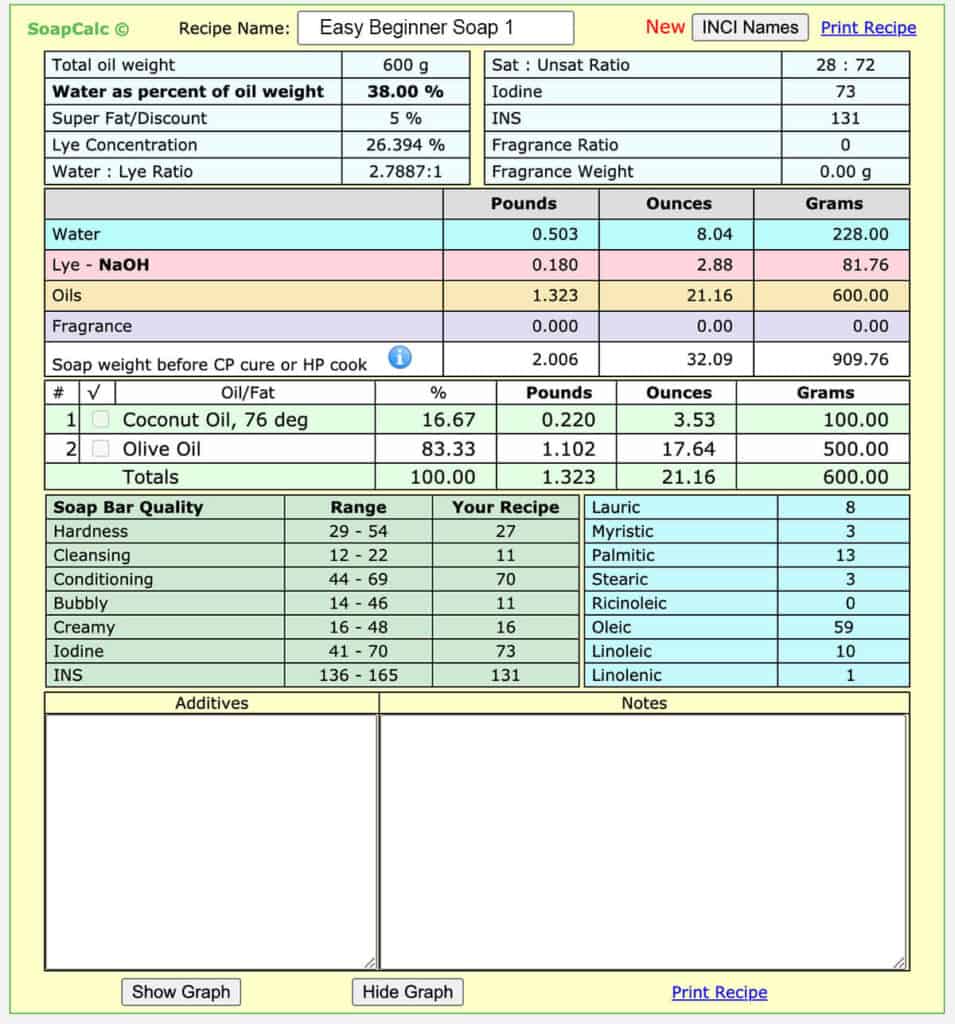
Adjusting your recipe
Once you have an idea of what type of soap your recipe might make, you may want to make some adjustments.
Let’s use the example of my Easy Beginner Soap recipe. Many people have made and love that soap, but it’s a soap that falls slightly out of the soap qualities range on Soapcalc.
Making a more cleansing soap with more lather
As written, my recipe falls slightly below the ranges they suggest for cleansing, hardness, and bubbly-ness. To adjust the soap to have it fit within the ranges, we could either increase the amount of coconut oil or add an animal fat.
To keep the soap simple, I decided to reduce the amount of olive oil from 500g to 450g. I then increased the amount of coconut oil from 100g to 150g. By making that minor adjustment, you can see that the soap now falls within the suggested ranges in the Soapcalc lye calculator.
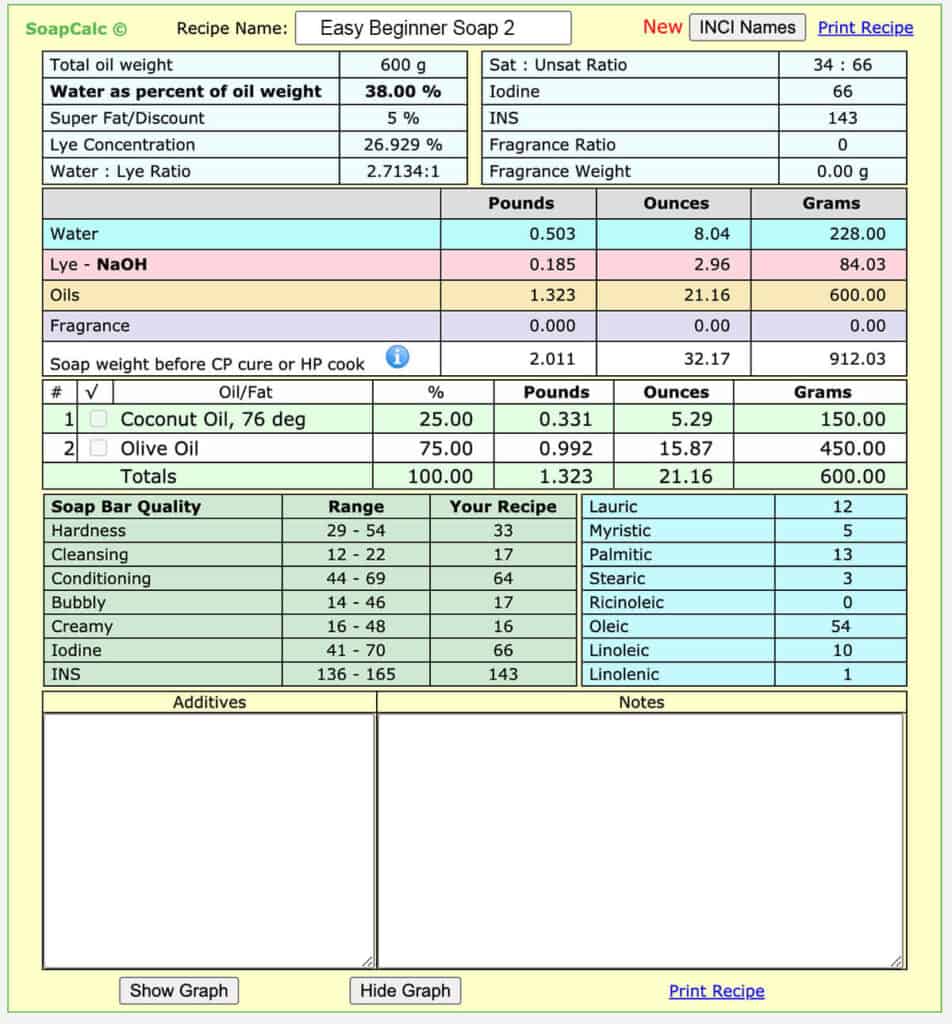
Making a more conditioning soap
Using this same idea, you can adjust any soap, as needed. If it’s not conditioning enough, perhaps try increasing the amount of olive oil. The addition of different liquid oil might also help.
See my guide to the best oils for soapmaking to get a better idea about what oils to use to adjust the recipe to your liking.
Not in range?
Keep in mind that the numbers given by the soap calculator are just a guideline. Some soaps, like a pure Castile soap, will not fit into the given ranges for all of the soap qualities. That is OK. The numbers should make you aware of what you can expect, though.
Some people absolutely love pure Castile soaps for their conditioning nature. On the other hand, a lot of people dislike them because they want a soap that lathers more and cleans more thoroughly.
What’s most important is that you make a soap that fits your purpose, one that you enjoy.
The best lye calculator for liquid soaps
Again, it’s debatable which lye calculator is best for calculating liquid soap recipes. That said, I prefer to use the advanced lye calculator by Summer Bee Meadows. It is now called SBM Crafters Advanced Soap Calculator.
You may have noticed that the bar soap recipes on my blog are given in grams, but my liquid soap recipes are done in ounces. (I do give a convertor within the recipe card, though, so you can still work in either.) The reason for that is that the SBM Crafters calculator only gives you the option to work in ounces.
I began using this particular lye calculator years ago because I had read that it was the most accurate at the time. This was mainly because they are said to account for the impurities in lye.
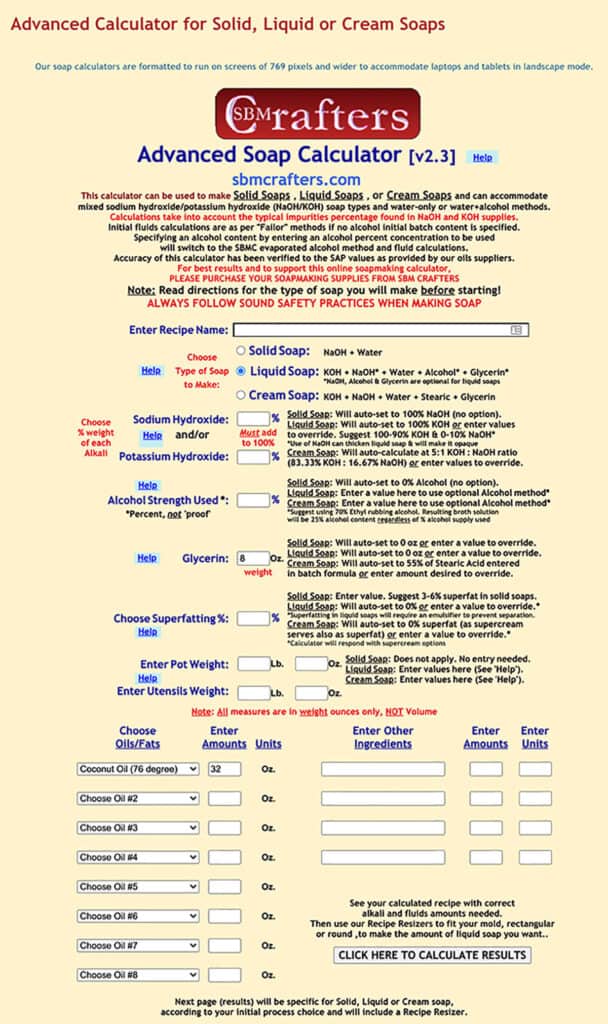
Glycerin in liquid soap
What I found especially helpful in this lye calculator, though, is that it allows for adding glycerin as part of the liquid in your soap. Glycerin is a great addition to liquid and cream soaps. It helps speed up the soap making process and makes it more fail-proof (which is especially good for beginners.)
Other benefits to adding glycerin to liquid soaps is that they tend to be easier to dilute and may be milder soaps because of the humectant properties of glycerin (which help draw moisture into the skin).
Calculating liquid or cream soap recipes
After having gone through the steps to using the Soapcalc lye calculator, this one is pretty much the same. So, I won’t go into quite as much detail about the process. I will try to explain some of what is different in this lye calculator.
KOH and/or NaOH
In this case, we begin by choosing the type of soap we are going to make: bar soap, liquid soap, or cream soap. Most bar soaps are made with only NaOH (sodium hydroxide). Liquid soap are usually made with KOH (potassium hydroxide) or mostly KOH with some NaOH. Cream soaps are generally made with a combination of the two types of lye. (The default given is 5:1 KOH:NaOH.)
You can use the default values for your type of soap, or override them.
The alcohol and glycerin methods
The next sections allow you to optionally add alcohol, for using the alcohol method of liquid or cream soap making, or glycerin. Neither is necessary, but I like adding some glycerin to my liquid soaps. I prefer to make a soap paste, vs. the alcohol method of soap making, but if you are interested in learning more about the alcohol method, information can be found in Making Natural Liquid Soaps by Catherine Failor.
Superfatting liquid soaps
I normally don’t superfat my liquid soap recipes to avoid cloudiness in my liquid soaps. The default for superfatting liquid soaps is 0%, so that works well for me.
Calculating the recipe
I also ignore the sections about pot and utensil weight and move directly to the part where you input the oils you want to use.
Once inputted, I click on the “Click here to calculate results” button, and the page refreshes with the calculated recipe.
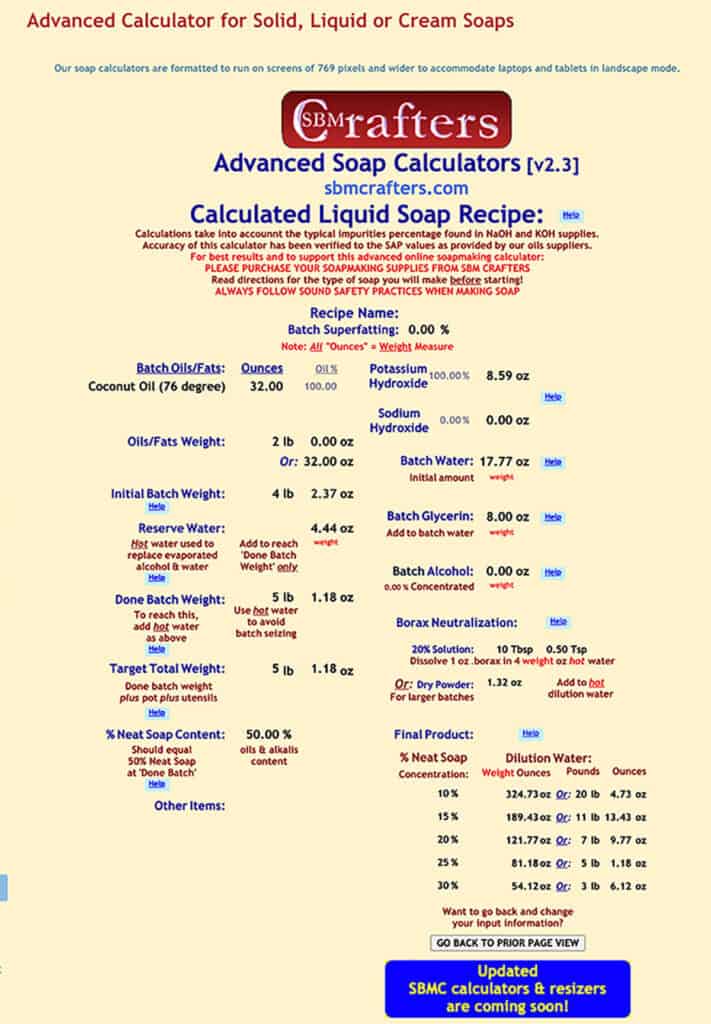
Above you can see the final calculated liquid soap recipe. It shows how much water and glycerin to add, and also provides other information. For example, if you were to choose to “neutralize” your liquid soap with borax, it gives guidelines about how much to add.
Neutralizing liquid soaps
I generally don’t neutralize my liquid soaps with borax, and haven’t found it necessary when making the recipes exact. (That means that I don’t superfat them, but I don’t use a lye excess either.) For more information about the subject, though, see my post on neutralizing liquid soaps.
Gaining confidence
As with all things, you’ll feel more confident about altering and formulating your own recipes as you make more soaps. At first, this may all seem very intimidating. In actuality, though, it’s really a simple (and fun) process.
 Español
Español
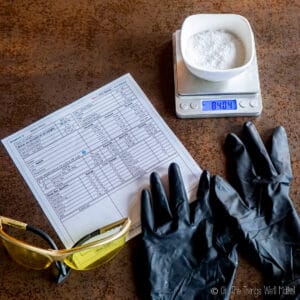
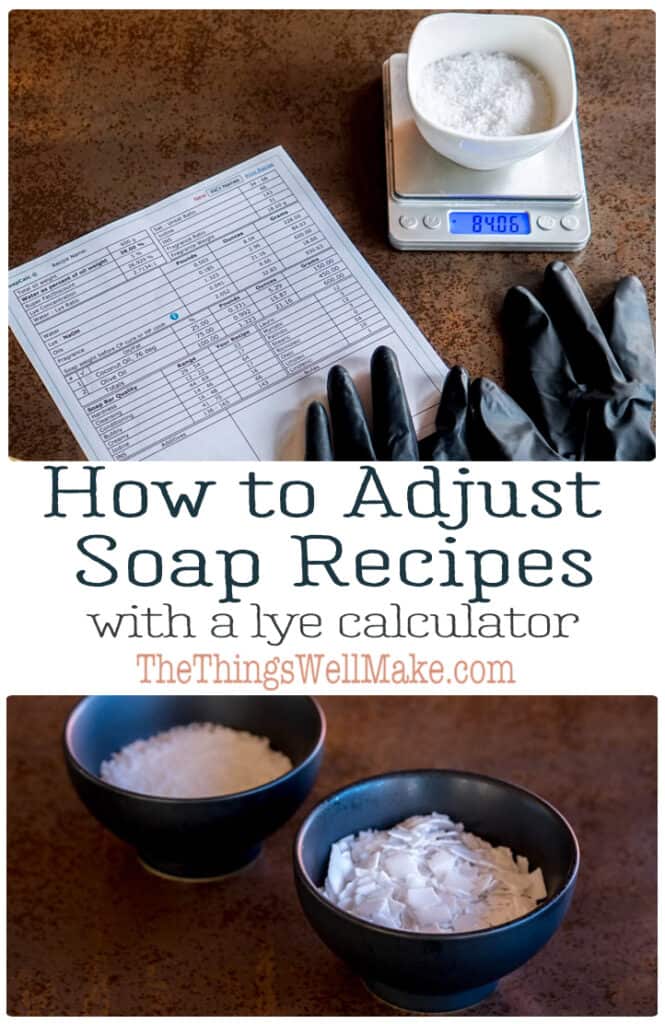
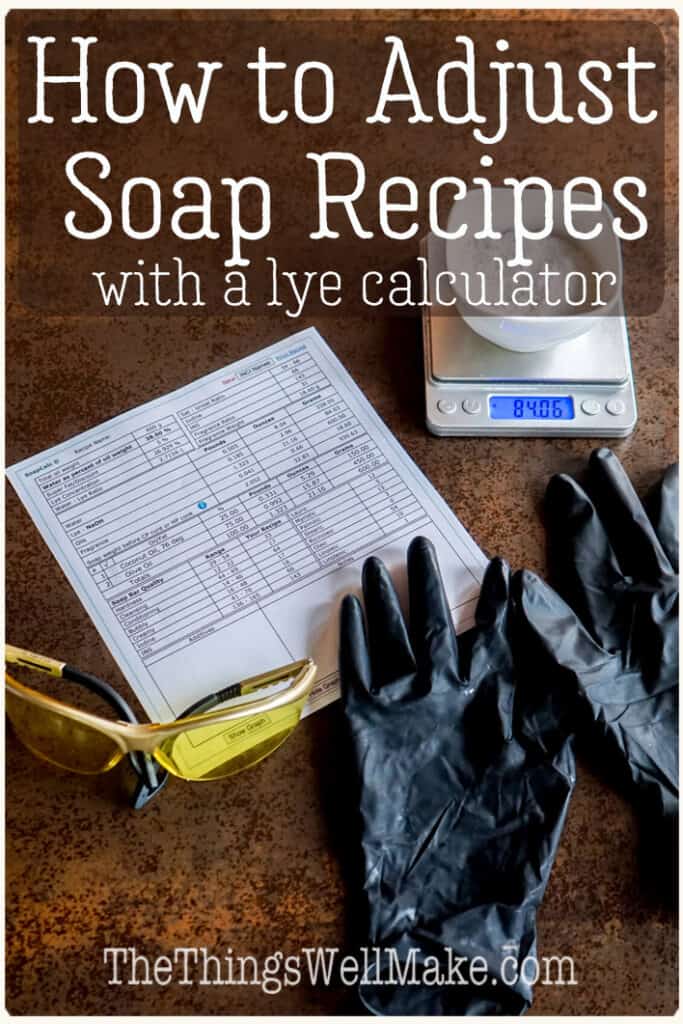
 The Best Oils for Soap Making
The Best Oils for Soap Making
Kristian
Hi, the Lye Calculator for LIQUED Soaps, no longer works. Do you by chance have a Liquid Soap Calculator that has an active link? Thanks so much 🙂
Tracy Ariza, DDS
Hi Kristian,
I was just able to get to it, but I do get a safety warning from my browser before going to it. It appears they aren’t being good about keeping up security certificates for their website or something.
I’ll have to look into other options as they don’t appear to be active lately. I am not aware of others that allow for the calculation with glycerin (that I like) and am not sure how accurate the others are for liquid soaps. I’ll have to investigate and update the post!
Eric
SBM Soap Calculator broken
Tracy Ariza, DDS
Hmmm- I think it’s just a problem with their security settings not being up to date. (They may not have switched to https from HTTP or something like that.) But, yes, it is still not easily accessible. I’m hoping they fix it because it’s a great lye calculator for liquid soaps.
Shirley crabbe
Thanks for sharing information that is easy to understand for us beginners .
Can I add some glycerine to your basic soap recipe and will it affect the Lye / Water ratio?
Thanks in advance.
Shirley
Tracy Ariza, DDS
Hi Shirley,
While I normally only add glycerin to my liquid soaps and glycerin soaps, yes, you should be able to add some to any soap. Keep in mind that glycerin is a “solvent” of sorts that can eat away at some of the crystalline structure of the soap. This can make it slightly softer and can also change the appearance of the soap (making it more translucent).
So, it’s a good idea to do so with bars of soap that are on the harder side. (Normally those with more solid oils/waxes)
You can exchange the glycerin for part of the water and can either mix it with the water before adding the lye or after.
Ashokan Subbarayan
Hi Trazy,
Your way of presenting information is awesome. You exactly know the painpoints of your readers and give clear, neat, exact info. Hats off to you ..
Can I have my query cleared here?
I made glycerin soap with glycerine noodles available in market (Chennai, India). But small bubbles come out at the time of pouring the melted base into the silicone mold which I am unable to remove. Can you pl.guide me to overcome this issue?
Tracy Ariza, DDS
Hi Ashokan,
Thank you so much. I really appreciate it.
As for your question. I’m assuming that the glycerin noodles are sort of like a pre-made melt-and-pour base?
I don’t generally work with them, but did experiment with making transparent soaps for a while, and I’m guessing the same tips would apply.
One of the more important things is to be very gentle when handling it. Stir slowly, etc. The more you move it, the more bubbles will form. (If you can gently heat over very low heat and melt them without moving them at first, all the better.)
Another great tip is to spray some cosmetic grade alcohol over the soap to help clear the bubbles. If the soap is transparent, you may want to do this little by little. (Pour some into the mold, spray alcohol on it, then pour some more in, spray again, etc.)
Princess
Wow thank you so much Tracy. I was clueless and you literally lifted off the blinders. I now know how to use a soap calculator without watching a youtube video.
Bob
Hello. I have a question about lye that has nothing to do with soap. I put a mixture of 2 tablespoons of cooking lye in a gallon of water on wood for furniture. It creates a stressed look thats nice with stain. Is this a safe mixture ratio in regards to ph.? Not a question that many can answer. Thank you.
Tracy Ariza, DDS
Hi Bob,
I’d avoid touching it while you are doing that, but as long as you do it with gloves on, I don’t see why there is any problem with that.
I made some lye cured olives and the process turned my wooden spoons a darker color that I actually happened to love. I am still using the spoons without issues. 😉
I write more about my thoughts about lye in this post about lye.
Njakam tchamabo louis
I appreciate the way u talk about fatty materials and how to combine all of them for a proper soap according to our need.I work with soap industry since nineteen years today,but,your various analysis open my eyes more and more.
thank you